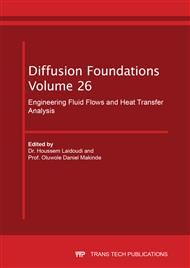[1]
W.H. Finlay, K. Nandakumar, Onset of two-dimensional cellular flow in finite curved channels of large aspect ratio, Phys. Fluids. A 2 (7) (1990) 1163–1174.
DOI: 10.1063/1.857617
Google Scholar
[2]
W.R. Dean, Note on the motion of fluid in a curved pipe, Philos. Mag. 4 (1927) 208–223.
Google Scholar
[3]
H. Fellouah et al., the Dean instability in power-law and Bingham fluids in a curved rectangular duct, J. Non-Newtonian Fluid Mech. 165 (2010) 163–173.
DOI: 10.1016/j.jnnfm.2009.10.009
Google Scholar
[4]
H. Fellouah et al., A criterion for detection of the onset of Dean instability in Newtonian fluids, European Journal of Mechanics B/Fluids. 25 (2006) 505–531.
DOI: 10.1016/j.euromechflu.2005.11.002
Google Scholar
[5]
M. Jarrahi, Secondary flow patterns and mixing in laminar pulsating flow through a curved pipe, Exp Fluids. 50 (2011)1539–1558.
DOI: 10.1007/s00348-010-1012-z
Google Scholar
[6]
S. Rout, A Laminar Fluid Flow and Heat Transfer Characteristics of Al2O3 Nanofluid in 180-degree Return Bend Pipe. 10(6) (2017) 81–89.
Google Scholar
[7]
M. Norouzi et al., Flow of second-order fluid in a curved duct with square cross-section, J. Non-Newtonian Fluid Mech. 165 (2010) 323–339.
DOI: 10.1016/j.jnnfm.2010.01.007
Google Scholar
[8]
Joana M. Malheiro et al. Parametric study on the three-dimensional distribution of velocity of a FENE-CR fluid flow through a curved channel, Journal of Non-Newtonian Fluid Mechanics. 200 (2013) 88–102.
DOI: 10.1016/j.jnnfm.2012.12.007
Google Scholar
[9]
P.K. Papadopoulos, P.M. Hatzikonstantinou, Numerical study of laminar fluid flow in a curved elliptic duct with internal fins. 29 (2008) 540–544.
DOI: 10.1016/j.ijheatfluidflow.2007.11.003
Google Scholar
[10]
Y. Li et al., Dean instability and secondary flow structure in curved rectangular ducts, International Journal of Heat and Fluid Flow. 68 (2017) 189–202.
DOI: 10.1016/j.ijheatfluidflow.2017.10.011
Google Scholar
[11]
Z.P. Dai, Z.Q. Yin, Flow and deposition characteristics of nanoparticles in a 90° square bend, Thermal Science. 19(4) (2015)1235–1238.
DOI: 10.2298/tsci1504235d
Google Scholar
[12]
B.B. Nayak et al. Numerical prediction of flow and heat transfer characteristics of water-fly ash slurry in a 180° return pipe bend, International Journal of Thermal Sciences. 113 (2017) 100–115.
DOI: 10.1016/j.ijthermalsci.2016.11.019
Google Scholar
[13]
H. Soltanipour et al. Numerical analysis of heat transfer enhancement with use of nonofluid and longitudinal ribs in curved duct. Thermal Science, 16(2) ( 2012) 469-480.
DOI: 10.2298/tsci110719028s
Google Scholar
[14]
M.R.H. Nobari, M.T. Mehrabani, A numerical study of fluid flow and heat transfer in eccentric curved annuli, International Journal of Thermal Sciences. 49 (2010) 380–396.
DOI: 10.1016/j.ijthermalsci.2009.07.003
Google Scholar
[15]
Tilak T. Chandratilleke, Nima Nadim, Ramesh Narayanaswamy. Vortex structure-based analysis of laminar flow behavior and thermal characteristics in curved ducts. International Journal of Thermal Sciences 59 (2012) 75–86.
DOI: 10.1016/j.ijthermalsci.2012.04.014
Google Scholar
[16]
F. Bouzit, H. Laidoudi, M. Bouzit. Simulation of power-law fluids and mixed convection heat transfer inside of curved duct. Defect and Diffusion Forum, 378 (2018) 113-124.
DOI: 10.4028/www.scientific.net/ddf.378.113
Google Scholar
[17]
F. Bouzit, H. Laidoudi, M. Bouzit. Numerical investigation of power-law fluid flows and heat transfer inside of curved duct under aiding thermal buoyancy. Diffusion Foundation, 16 (2018) 84-95.
DOI: 10.4028/www.scientific.net/df.16.84
Google Scholar
[18]
M. Mokkedem, H. Laidoudi, M. Bouzit. 3D Simulation of Dean vortices at 30° position of 180° curved duct of square cross-section under opposing buoyancy. Defect and Diffusion Forum, 389 (2018) 153-163.
DOI: 10.4028/www.scientific.net/ddf.389.153
Google Scholar
[19]
M. Mokkedem, H. Laidoudi, O. D. Makinde, M. Bouzit. 3D Simulation of incompressible Poiseuille flow through 180° curved duct of square cross-section under the effect of thermal buoyancy. Periodica Polytechnica Mechanical Engineering, 63(4) (2019) 257-269.
DOI: 10.3311/ppme.12773
Google Scholar
[20]
B. Bara, K. Nandakumar, J.H. Masliyah, An experimental and numerical study of the Dean problem: flow development towards two-dimensional multiple solutions, J. Fluid Mech. 244 (1992) 339–376.
DOI: 10.1017/s0022112092003100
Google Scholar
[21]
ANSYS CFX-Solver Theory Guide, ANSYS Ltd., (2006).
Google Scholar


